Wednesday, April 16. 2014
Via The Programmable City
-----

On Thursday April 10, the space agency is set to reveal its enormous database of where to find software for more than 1,000 of its projects (probably including rocket guidance, robotic control and/or climate simulators).
More about it on MailOnline.
Wednesday, January 15. 2014
Via MIT Technology Review
-----
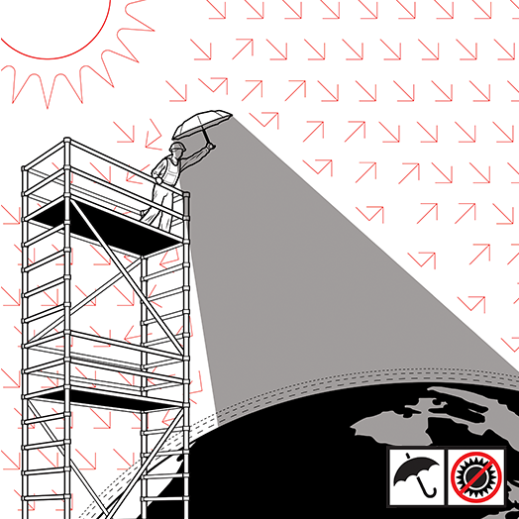
Illustration by McKibillo
More than a decade ago, Paul Crutzen, who won the 1995 Nobel Prize in chemistry for his research on the destruction of stratospheric ozone, popularized the term “Anthropocene” for Earth’s current geologic state. One of the more radical extensions of his idea—that human activity now dominates the planet’s forests, oceans, freshwater networks, and ecosystems—is the controversial concept of geoengineering, deliberately tinkering with the climate to counteract global warming. The logic is straightforward: if humans control the fate of natural systems, shouldn’t we use our technology to help save them from the risks of climate change, given that there’s little hope of cutting emissions enough to stop the warming trend?
In recent years a number of scientists—including Crutzen himself in 2006—have called for preliminary research into geoengineering techniques such as using sulfur particles to reflect some of the sun’s light back into space. With the publication of A Case for Climate Engineering, David Keith, a Harvard physicist and energy policy expert, goes one step further. He lays out arguments—albeit hedged with caveats—for actually deploying geoengineering. He says that releasing sun-blocking aerosol particles in the stratosphere (see “A Cheap and Easy Plan to Stop Global Warming,” March/April 2013) “is doable in the narrow technocratic sense.”
Indeed, Keith is steadfastly confident about the technical details. He says a program to cool the planet with sulfate aerosols—solar geoengineering—could probably begin by 2020, using a small fleet of planes flying regular aerosol-spraying missions at high altitudes. Since sunlight drives precipitation, could reducing it lead to droughts? Not if geoengineering was used sparingly, he concludes.
Australian ethicist Clive Hamilton calls the book “chilling” in its technocratic confidence. But Keith and Hamilton do agree on one thing: solar geoengineering could be a major geopolitical issue in the 21st century, akin to nuclear weapons during the 20th—and the politics could, if anything, be even trickier and less predictable. The reason is that compared with acquiring nuclear weapons, the technology is relatively easy to deploy. “Almost any nation could afford to alter the Earth’s climate,” Keith writes. That fact, he says, “may accelerate the shifting balance of global power, raising security concerns that could, in the worst case, lead to war.”
Thing reviewed
A Case for Climate Engineering
David Keith MIT Press, 2013
The potential sources of conflict are myriad. Who will control Earth’s thermostat? What if one country blames geoengineering for famine-inducing droughts or devastating hurricanes? No treaties ban climate engineering explicitly. And it’s not clear how such a treaty would operate.
Keith professes ambivalence about whether humans are truly able to wield such powerful technology wisely. Yet he feels that the more information scientists uncover about the risks of geoengineering, the lower the chances the technology will be used recklessly. Though his book leaves unanswered many of the questions that arise over how to govern geoengineering, a policy paper that he published in Science last year goes further to address them: he and a coauthor proposed government authority over research and a moratorium on large-scale geoengineering but said there should be no treaties regulating small-scale experiments.
Hamilton says this approach would lead nations on a path toward the conflict that he thinks would inevitably surround geoengineering. Allowing lightly regulated small experiments, he suggests, could undermine the urgency of political efforts toward cutting emissions. This, in turn, increases the possibility that geoengineering will be used, since failing to restrain emissions will leave temperatures rising. Hamilton accuses Keith of seeking a “naïve … cocoon of scientific neutrality” and says researchers cannot “absolve themselves of responsibility for how their schemes might be used or misused in the future.”
That may be true, but Keith deserves credit for directing attention to ideas he knows are dangerous. Accepting the concept of the Anthropocene means accepting that humans have the responsibility to find technological fixes for disasters they have created. But little progress has been made toward a process for rationally supervising such activity on a global scale. We need a more open discussion about a seemingly outlandish but real geopolitical risk: war over climate engineering.
Personal comment:
"Who will control Earth’s thermostat?" Oh well, following yesterday's news, I would suggest Google, they have "smart" technology ...
By the way, will we also reach some "climate neutrality quash" one day (compared to "net neutrality quashed" by a federal court), once global weather will definitely be an artifact and a product?
Saturday, September 21. 2013
By fabric | ch
-----
Deterritorialized Living is a new project by fabric | ch that we've just published online last week, in relation with the Call and the Talks we are presenting during Close, Closer, the 3rd Lisbon Architecture Triennale curated by Beatrice Galilee (first talk is today, September, 21 at 5pm, LX Factory, Rua Rodrigues Faria, Lisbon, while the second one will be on December, 14).
This project is the result of a residency we did in Beijing last spring, at the Tsinghua University (TASML) and has certainly some unconscious relation with the experience of climate we had in the city!

http://www.deterritorialized.org, the server of Deterritorialized Living, the artificial and livable troposphere.
Deterritorialized Living is an artificial troposphere that reverses our causal relationship to the natural rhythms of day and night, air, seasons, time. It is a “man made” environment where the atmosphere is the effect, continuously shaped from the global activities on the networks produced by humans and robots. The aim of this artificial, almost fictional atmosphere is to give permanent presence (at this stage only in the form of data flows) to what has paradoxically become an ambient, "atmospheric" and contextual experience of deterritorialisation / detemporalisation induced by the massive use of networks, transportation devices, flows of data or communication technologies. Therefore, to literally become able to "breathe" the environment we are generating through our common actions. To some extent, Deterritorialized Living could then also be considered as an information design, delivered in the form of an atmosphere.
As the result of its initial and designed rules, this milieu develops strange behaviors: daylight is always “on” (as there are always activities on the networks) but at variable strengths, nighttime never occurs, air composition regularly reaches “physiological enhancement” levels of high altitude, it is composed of a unique single day that goes back and forth and that ideally last forever, continuous. There are no months, no years.
Deterritorialized Living is delivered in the form of open data feeds which define this “geo-engineered” yet livable environment, computed by the deterritorialized.org server. We expect to develop and use the troposphere in the future in the form of installations, responsive devices and architecture projects.
But the artificial troposphere is also freely available to architects, artists, designers, scientists and makers of all kinds in the form of different “services”: Deterritorialized Air (N2, O2, CO2, Ar), Deterritorialized Daylight (visible light Intensity, IR, UV) and Deterritorialized Time (HH:MM:SS). Additional feeds and refined rules will be added along the time to mature this generated atmosphere.
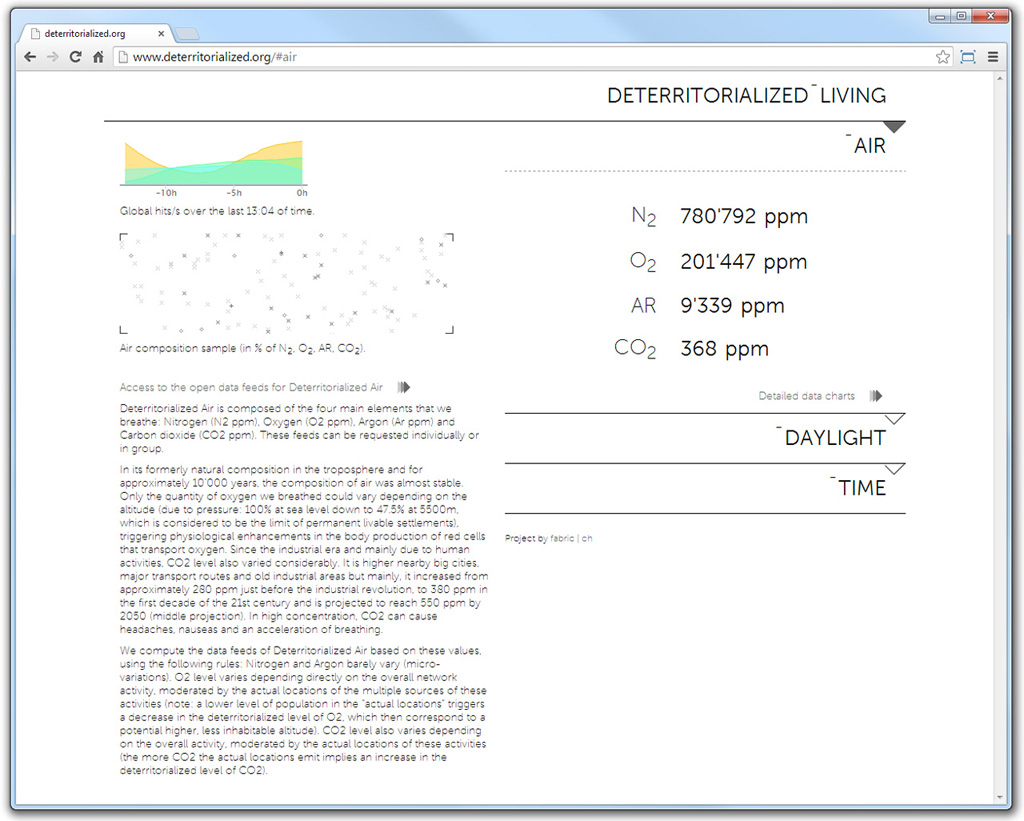
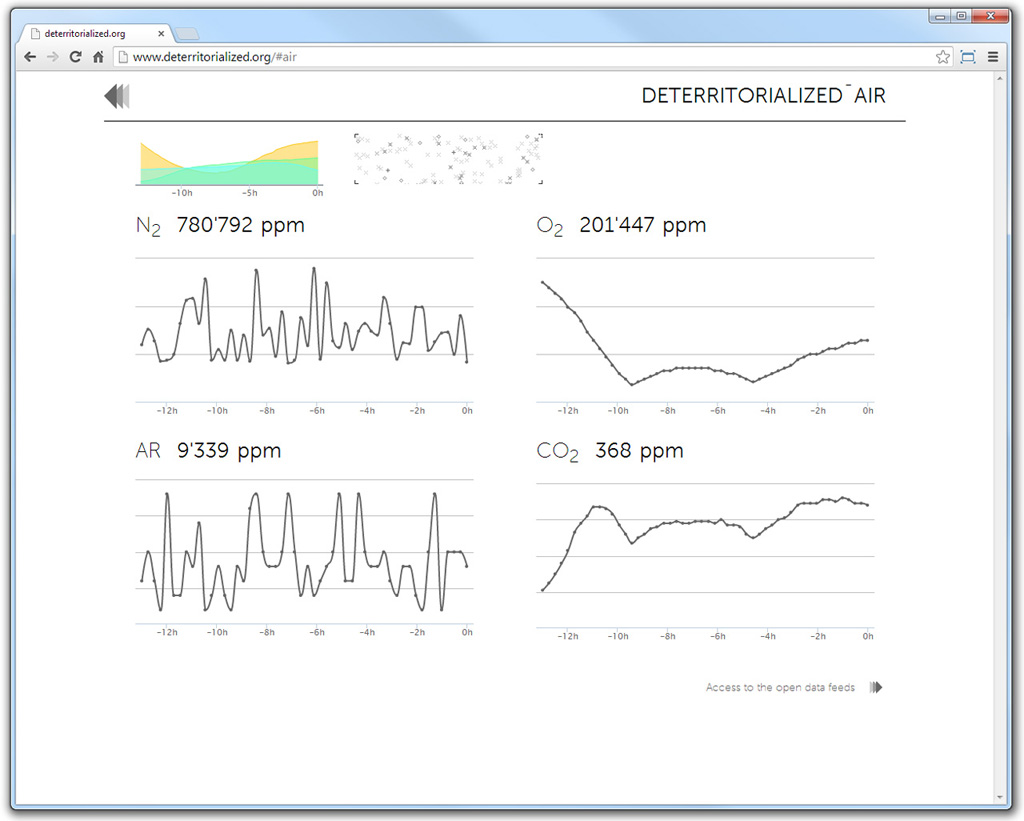
The live parameters, data and charts that show the evolution of values for Deterritorialized Air (N2, O2, AR, CO2).
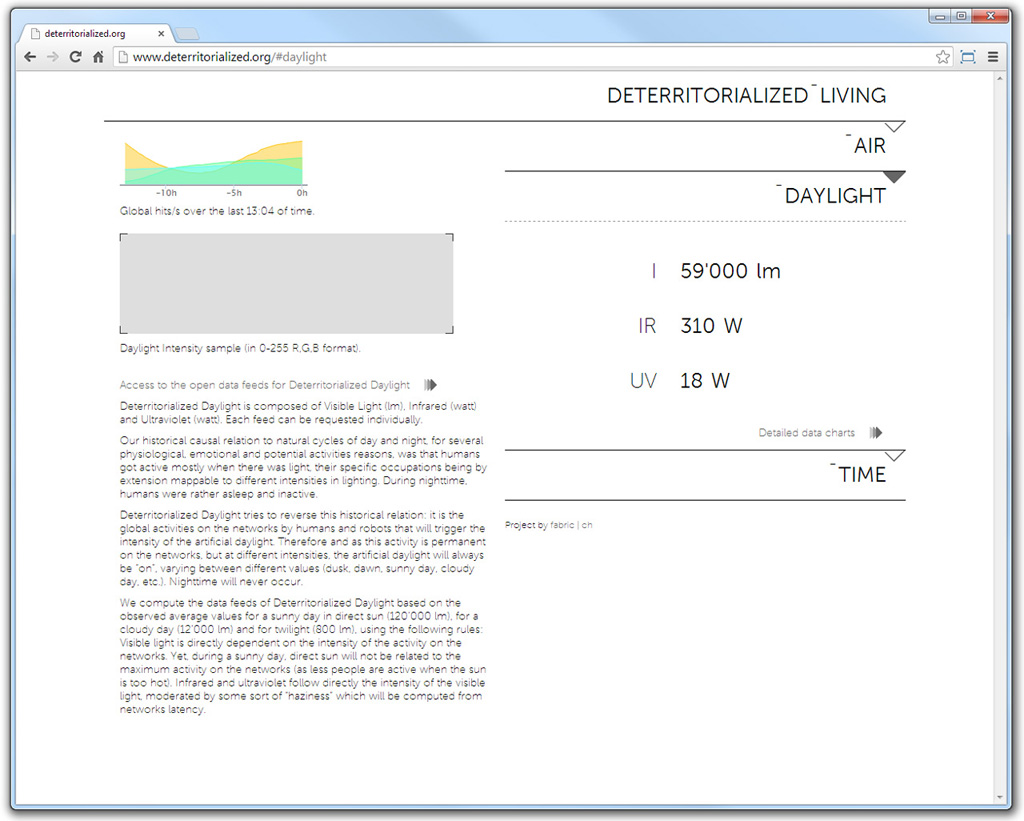
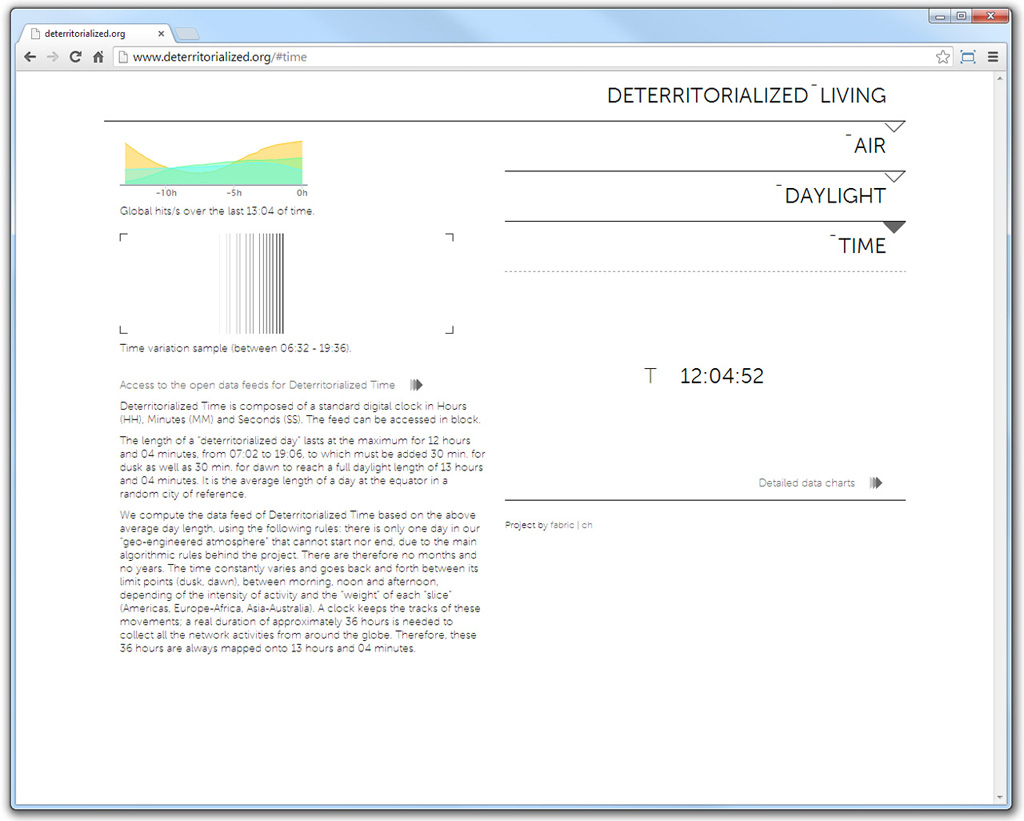
 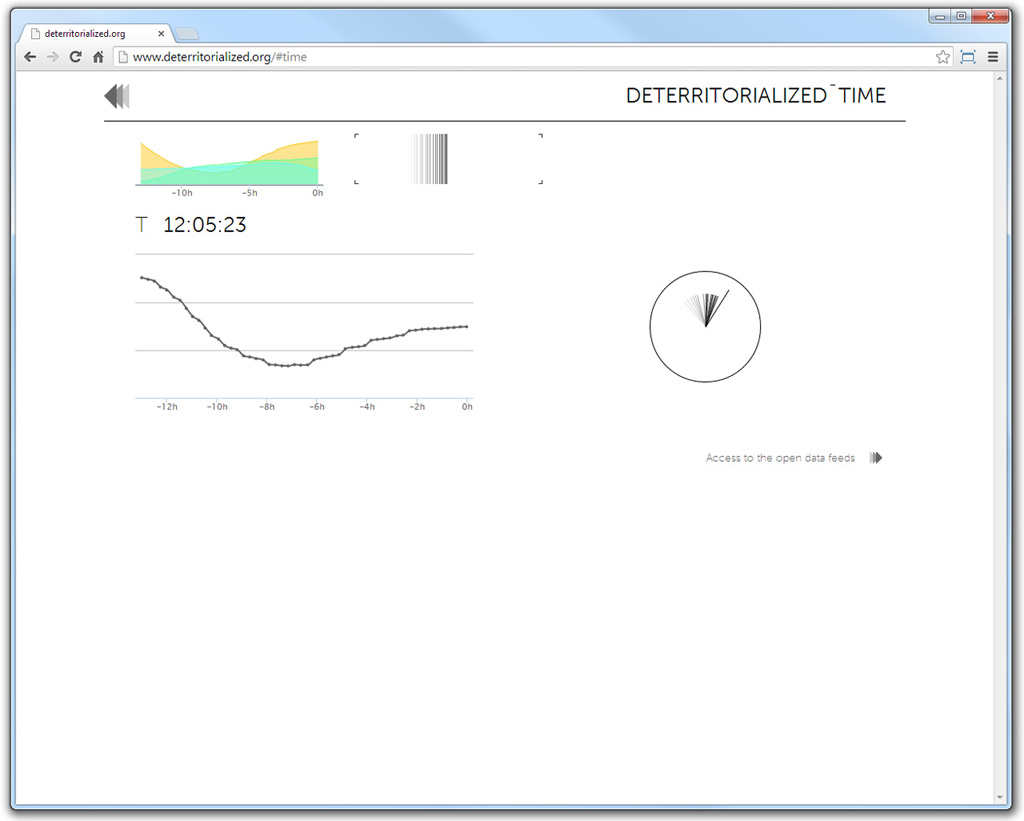
Values for Deterritorialized Daylight, including Intensity (lm, visible light), Infrared (w) and ultraviolet (w) as well as Deterritorialized Time (HH:MM:SS), with their related charts. It is interesting to note that the generated time changes along time... but not in a linear manner, it varies between 06:32 and 19:36.

Man page explaining how to access the different data feeds for the ones who would like to develop their own project out of Deterritorialized Living.
These algorithmically designed data feeds can therefore be used independently or combined to drive experimental devices, interfaces, software and speculative livable environments of all kinds (under the responsibility of their authors...).
Let us know if you'll be using it!
Thursday, September 12. 2013
Via eVolo
-----
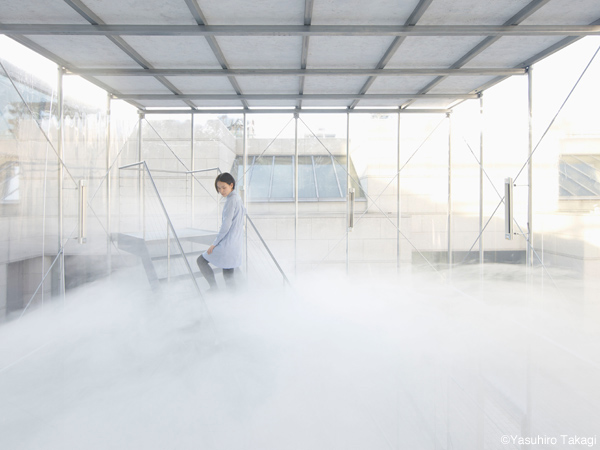
Tetsuo Kondo Architects created playful installation for the Sunken Garden of the Museum of Contemporary Art in Tokyo. In collaboration with Transsolar, they designed a small bank of clouds that are captured in the transparent, two-storey container and could be seen from the outdoor plaza, entrance hall, exhibition galleries and other parts of the museum. This cloud installation is the second one created by this team – trey previously collaborated to produce an indoor cloud at the Venice Biennale in 2010.
When one climbs the stairs beyond the clouds to reach the top of the cube, the museum, the surrounding buildings, and the sky stretch out above the clouds. The clouds are in constant motion and their edges are both sharp and soft. Color, density and brightness are ever changing, depending on the weather and the time of the day.
In order to keep the clouts at the desired height, the temperature and the humidity inside the container are precisely controlled. The air inside the container forms three distinct strata, one cool and dry, at the bottom, a warm and humid middle stratum, and a hot and dry stratum at the top. The clouds form in the warm, humid layer. The elastic material in the container, at a 6 meter ceiling height, makes the whole structure responsive to wind pressure while the double layers of vinyl sheets divide the strata to ensure the stability of the temperature and humidity inside the container.
The aim was to produce an experiment – a new type of architectural space which would achieve high level of integration in engagement with its environment. The structure is in tune with all the invisible changes in the nature that surrounds it – slightest differences in humidity and temperature and the weather, the time of the day and other aspects which influence each other.
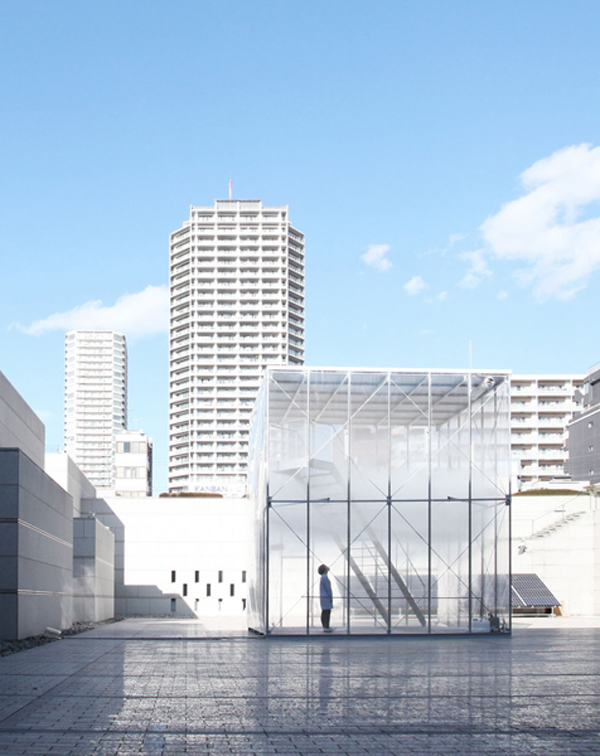
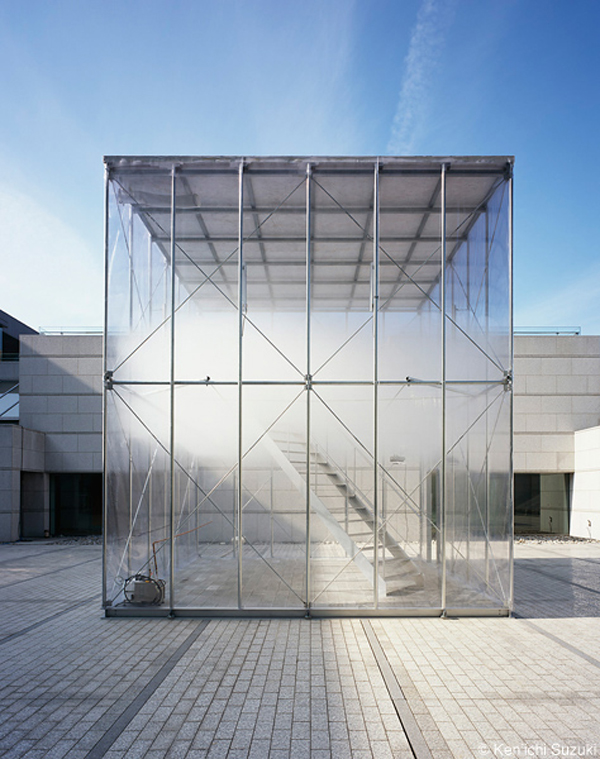
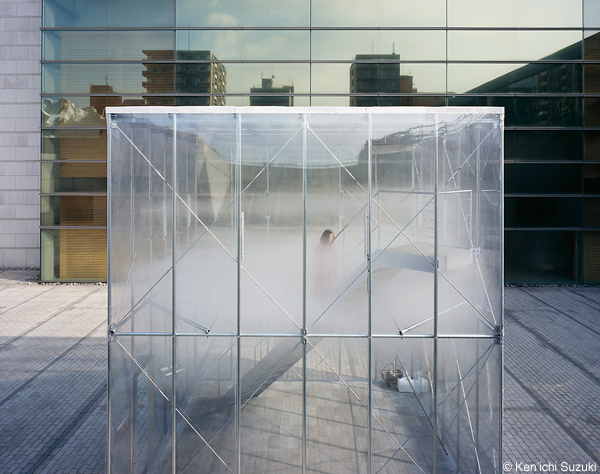

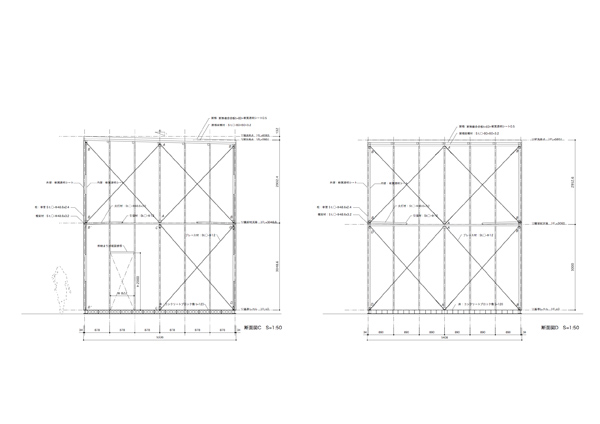
Tuesday, May 28. 2013
Via BLDGBLOG
-----
de noreply@blogger.com (Geoff Manaugh)
 [Image: Via the Extreme Environments & Future Landscapes program]. [Image: Via the Extreme Environments & Future Landscapes program].
Returning briefly to the theme of landscape devices—particularly in the run-up to the launch of Landscape Futures—I thought I'd post a quick look at a trip to the Arctic island of Svalbard last autumn led by David Garcia with students from the University of Lund School of Architecture.
As part of Lund's Extreme Environments & Future Landscapes program, students flew up to visit "the far north, beyond the Polar Circle, to Svalbard, to study the growing communities affected by the melting ice cap and the large opportunities for transportation and resources that the northeast passage now offers."
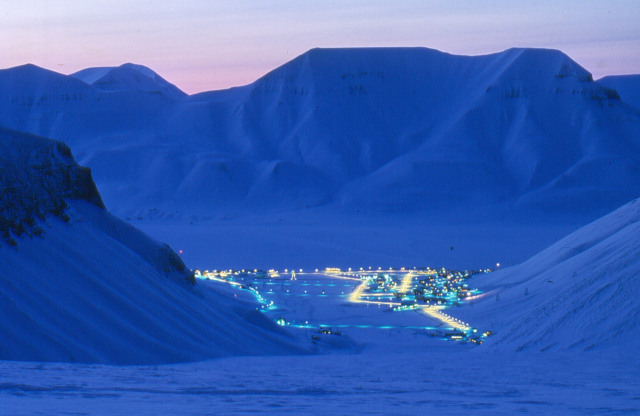 [Image: Via the Extreme Environments & Future Landscapes program]. [Image: Via the Extreme Environments & Future Landscapes program].
There, the students would also research first-hand the performance of "urban structures in the extreme cold."
  [Images: From a series of "light beacon studies" by Marta Nestorov]. [Images: From a series of "light beacon studies" by Marta Nestorov].
However, Garcia adds, during their time in the extreme environment of the north, the group also "tested and probed the surroundings with surveying equipment designed and built for the expedition, at urban and natural landscapes, from -30 degrees Celsius to overcast blackout weather."
 [Image: An instrument for analyzing "perception and interpretation of the aurora borealis" by Christopher Erdman]. [Image: An instrument for analyzing "perception and interpretation of the aurora borealis" by Christopher Erdman].
Some of that equipment is pictured here, ranging from a colorful audio device "used for testing sound absorption properties of snow" to a kind of portable oven meant for testing the thermal-insulation qualities of "ice tiles" that might someday be used in constructing frozen architecture.
 [Image: Device "for testing sound absorption qualities of snow," by Milja Lindberg and Liina Pikk]. [Image: Device "for testing sound absorption qualities of snow," by Milja Lindberg and Liina Pikk].
For their test of the acoustic properties of snow, for example, using tripods seen in the above photo, students Milja Lindberg and Liina Pikk designed an experiment that would operate "by transmitting sound onto snow and reflecting it to a receiver": The device consists of three parts. A blue transmitter tube (Ø 60mm) sends focused sound frequencies through a speaker fitted at one end of the tube. A red receiver tube 20mm wider in diameter picks up sound waves reflected from the snow test bed. Both tubes are connected to tripods with an angle adjuster that works as a protractor to set the right angle. This piece also connects two lasers on top of the tubes. The lasers meet in the middle of the snow test bed.
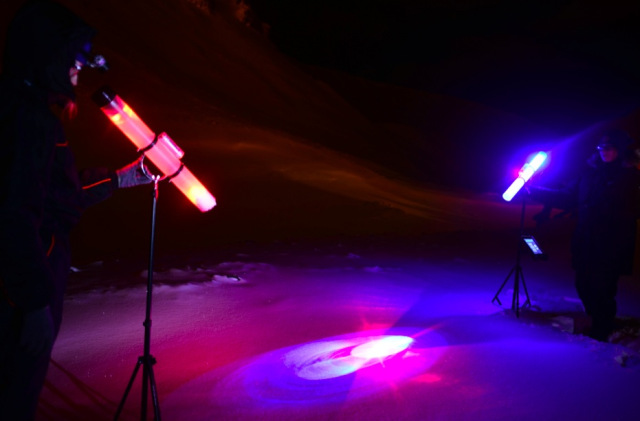  [Images: The aforementioned device "used for testing sound absorption qualities of snow," by Milja Lindberg and Liina Pikk]. [Images: The aforementioned device "used for testing sound absorption qualities of snow," by Milja Lindberg and Liina Pikk].
The accompanying pink & lavender light show lent a strangely theatrical air to the operation—perhaps also inadvertently revealing the possibility of designing "architecture" in snow-intensive environments using nothing but colored light.
 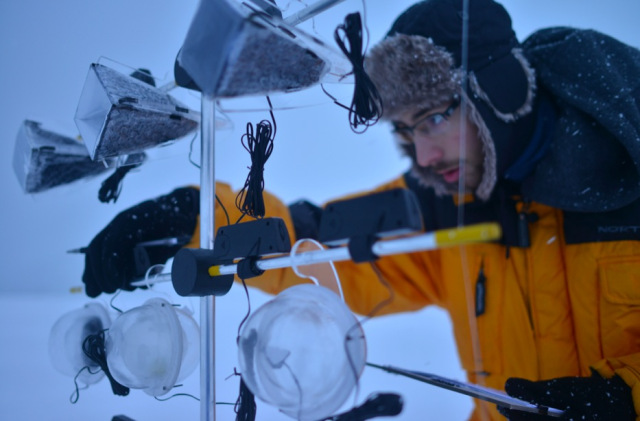 [Images: A device for performing "biomimicry of polar plants" by Clemens Hochreiter]. [Images: A device for performing "biomimicry of polar plants" by Clemens Hochreiter].
Clemens Hochreiter's installation for studying the "biomimicry of polar plants," meanwhile, was an attempt to reproduce the shapes of Arctic flowers in small translucent shells, in order to test—if I've understood this correctly—what architectural shapes might be most useful in future greenhouse design.
Hochreiter hoped to "clarify if it [is] possible to improve the microclimate within the flower shaped volumes by using transparent, translucent, light absorbing or light reflecting materials."
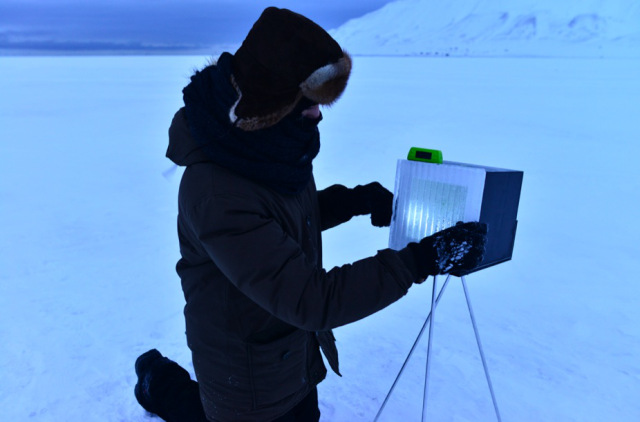 [Image: Device for studying the "insulation properties and light transmission" of ice tiles, by Daniela Miller]. [Image: Device for studying the "insulation properties and light transmission" of ice tiles, by Daniela Miller].
Continuing to move through the projects relatively quickly, we come to Daniela Miller's study, pictured above, which seems to be one of the more practical investigations of the bunch. Miller's goal was to analyze the ability of specially made "ice tiles" to insulate against heat loss as well as to transmit light.
   [Images: Ice tiles by Daniela Miller]. [Images: Ice tiles by Daniela Miller].
"The tiles are produced in different thicknesses," Miller explains, "and some of them encase different kinds of material. Using a heat source within the box, the insulation properties of the tiles can be measured with a thermometer.
The other series of studies deals with the translucency of the tiles. A light source is placed inside the box and the light intensity and quality crossing through the tile can be measured with a luxmeter."
The "different ice and snow plates were produced by use of a mould system," she adds, and each tile was subsequently "registered and analyzed to quantify the most relevant data"; this was all part of her attempt to explore "the potential of benefiting from ice and snow in architecture."
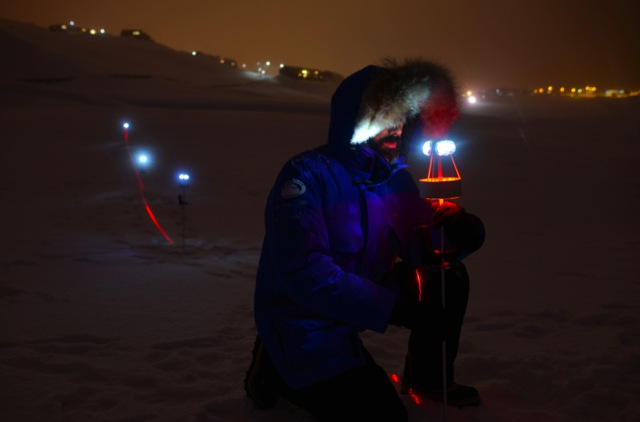  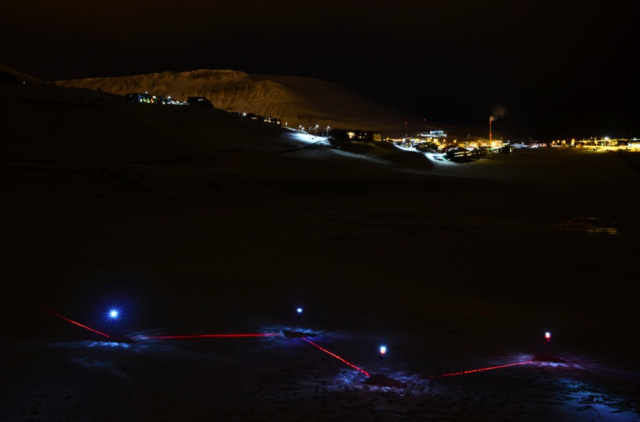  [Images: A "polar bear alarm" by studio director David Garcia]. [Images: A "polar bear alarm" by studio director David Garcia].
Finally, David Garcia himself built an alarm system for detecting polar bears, or what he calls "a 'soft' perimeter alarm, not one that will stop polar bears from approaching the designed area, but allows for an acoustic or visual alarm to be triggered."
Cue a team of screenwriters here to produce the world's first Arctic bear-heist film, in which enterprising 800-pound superthieves rumble up on a snow-covered city in the dark one winter and hatch a devious plan, subverting the red-laser alarm lights, slinking past optically-advanced high-tech fencing, and erasing their own paw-prints as they pull off the world's most spectacular case of ursine burglary. The Svalbard Job.
In any case, more images of other projects—and, in most cases, longer descriptions of each—are available on the expedition website.
Friday, April 19. 2013
Via Le Parisien via @chrstphggnrd
-----

Une douce chaleur règne chez 4 MTec, à Montrouge. Ici, pas de chauffage central, mais une quinzaine de Q.rad, les « radiateurs numériques » de la start-up Qarnot Computing, hébergée dans les locaux de ce bureau d’études. A l’origine de cette invention, Paul Benoît, ingénieur polytechnicien aux faux airs de Harry Potter, croit beaucoup dans son système « économique et écologique ».
Avec ses trois associés, dont le médiatique avocat Jérémie Assous, très investi dans la promotion du projet, une vingtaine de personnes planchent aujourd’hui sur sa mise en œuvre.
Le principe, que comprendront tous ceux qui ont déjà travaillé avec un ordinateur portable sur les genoux : utiliser la chaleur dégagée par des processeurs informatiques installés dans le radiateur. Vendue à des entreprises, des particuliers, des centres de recherche pour traiter des données ou faire du calcul intensif, leur utilisation suffit largement à couvrir la dépense en électricité. Avantage pour l’habitant du logement ainsi chauffé : c’est gratuit! Et pour les clients des serveurs informatiques, la garantie de tarifs bien inférieurs à ceux des coûteux data centers. Mais l’atout est aussi écologique : « notre système gaspille cinq fois moins d’énergie pour le même résultat », affirme Paul Benoît.
Pour son inventeur, le Q.rad ne connaît pas de limites. Qarnot Computing a réponse à tout : « On règle son chauffage comme on le souhaite, avec un thermostat. En fonction des besoins, nous régulons sur les différents radiateurs le flux des clients informatiques. » Et si ces derniers viennent à manquer? Aucun risque de panne hivernale, selon Paul Benoît : « Nous pourrons offrir gratuitement l’utilisation des serveurs à des chercheurs. » Et pour l’été? « Un mode basse consommation permet de conserver la moitié de la puissance de calcul en chauffant très peu. » Et si c’est encore trop, Qarnot Computing prévoit de la redéployer vers des lieux spécifiques, en équipant par exemple de Q.rad des écoles fermées pendant les grandes vacances. Mais l’ingénieur l’admet : pour son déploiement, la société a tout intérêt à privilégier les zones les plus froides…
300 Q.rad installés cet été dans la centaine de logements d’un HLM du XVe arrondissement parisien
Du côté des utilisateurs informatiques, c’est la question de la sécurité qui prime : là encore, Paul Benoît est sûr du résultat. « Nos systèmes ne stockent pas de données, elles ne font qu’y transiter de manière cryptée et à travers des calculateurs disséminés un peu partout. » Et si l’on tente d’ouvrir la machine, « elle s’arrête », prévient l’inventeur.
Des arguments qui ont déjà convaincu : le mois prochain, 25 radiateurs viendront chauffer l’école d’ingénieurs Télécom Paris Tech. Et à partir de cet été, ce sont quelque 300 Q.rad qui vont être installés dans la centaine de logements d’un HLM du XVe arrondissement parisien, à Balard. « Une première expérimentation à grande échelle, salue Jean-Louis Missika, l’adjoint parisien chargé de l’innovation et de la recherche, pour un projet qui pourrait être révolutionnaire! »
Personal comment:
While we are still located in Beijing for the moment (and therefore not publishing so much on the blog --sorry for that--) and while we are working with some students at Tsinghua around the idea of "inhabiting the data center" (transposed in a much smaller context, which becomes therefore in this case "inhabiting the servers' cabinet"), this news about servers becoming heaters is entirely related to our project and could certainly be used.
Wednesday, April 03. 2013
By fabric | ch
-----
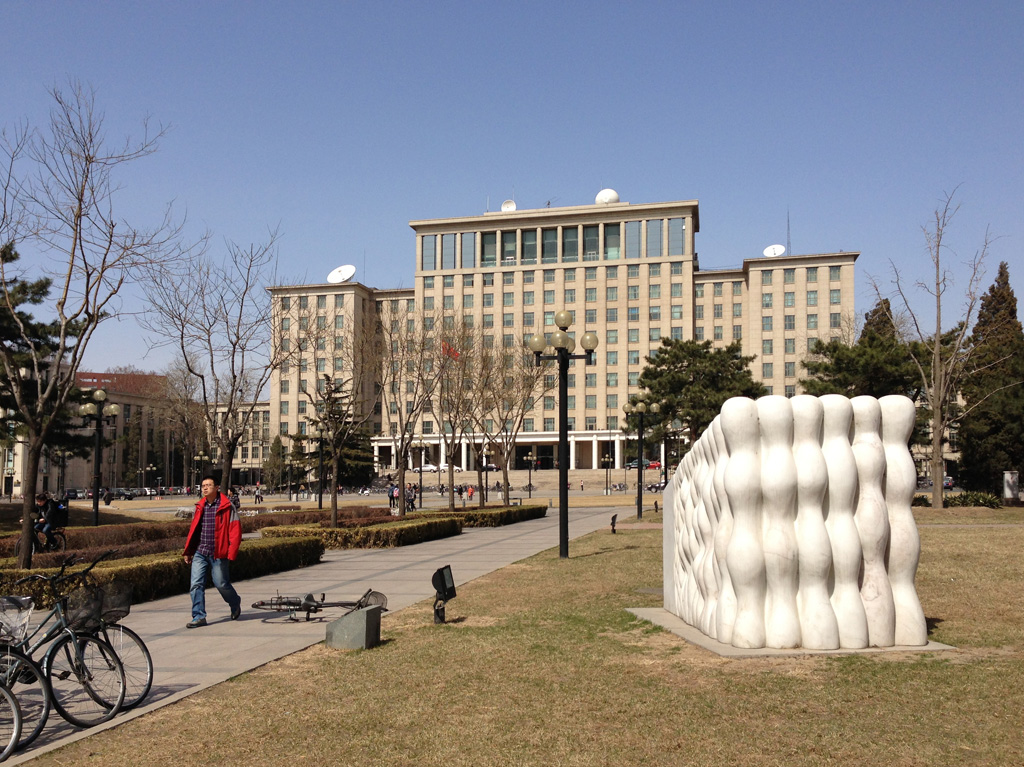
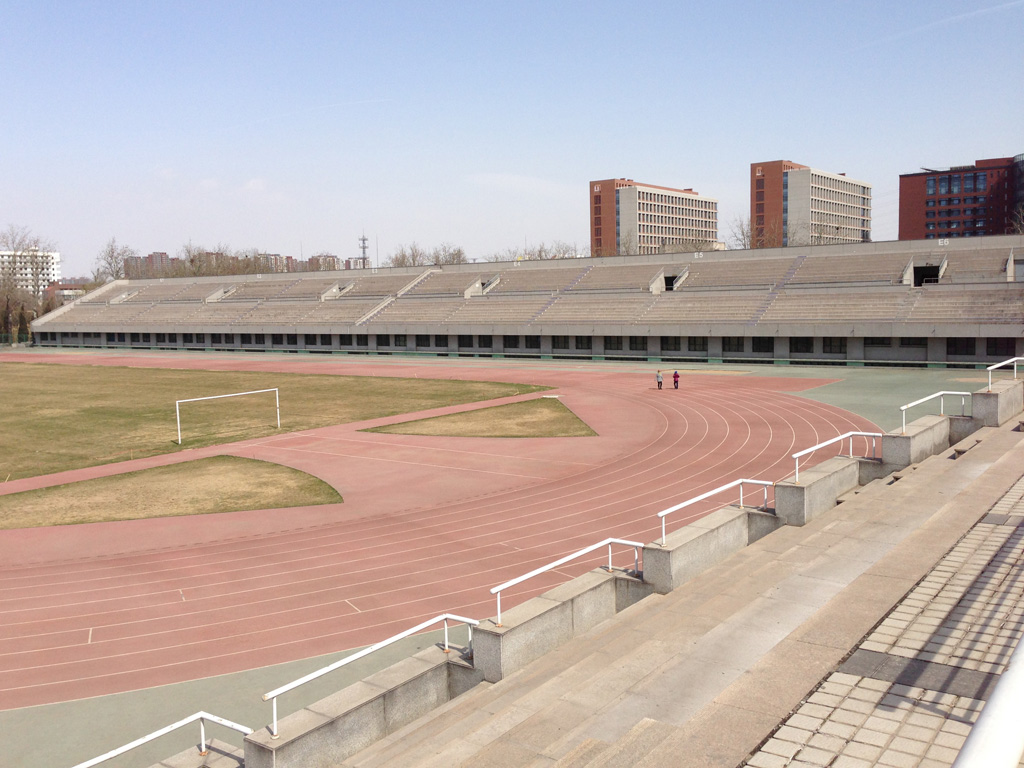 
At the invitation of Zhang Ga, curator and director of the TASML Lab at the Tsinghua University in Beijing (joint lab between Parsons School of Design and the Tsinghua University, in fact), to start develop a research project and run a short workshop with the students, I'm currently located for a month approximately alternatively on the campus and in town. The residency will last until mid July and other members of fabric | ch will come later.
We are starting here a new line of project that we've titled (so far) Deterritorialized Living and that will group several projects (Deterritorialized Daylight, Deterritorialized Air, Deterritorialized Heat and Deterritorialized House that will use some of these climatic elements to define a strange house).
The main idea of this project is to take on the emergent and yet almost invisible "icon" of the data center. To take it as a background for our project. A kind of re-emergence of the modern "international" ("ubiquitous"?) idea, transformed: a modern "specter", as Clog mentioned it. We try to question and anaylze it (its centrality, its ambiguous status of privately hosted if not owned people's data, its energy consuption, its heat production, its physical location and use of ressources, its seriality --rack structure--, etc.). But in fact, we want to push its own logic to its end: into a fully deterritorialzed way of living, with permanent --in fact almost useless-- access to (zombie) services and data, out of physical location and time zones. We want to study this situation and produce designs to respond to it.

The workshop part in itself that we are running here is a sub-subject of our own research, it is about inhabiting the computer cabinet or rather the servers cabinet, slightly extended therefore, but still minimal living. The workshop is entitled "Inhabiting the Computer Cabinet, with two suns", but I'll do a dedicated post about this later.

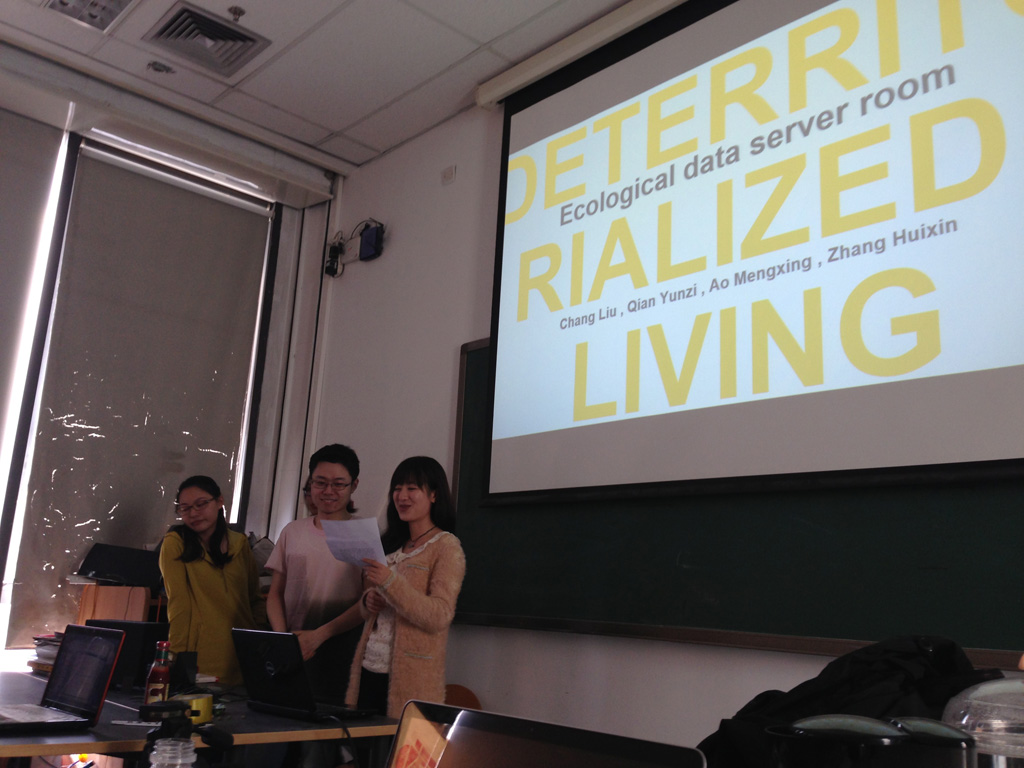 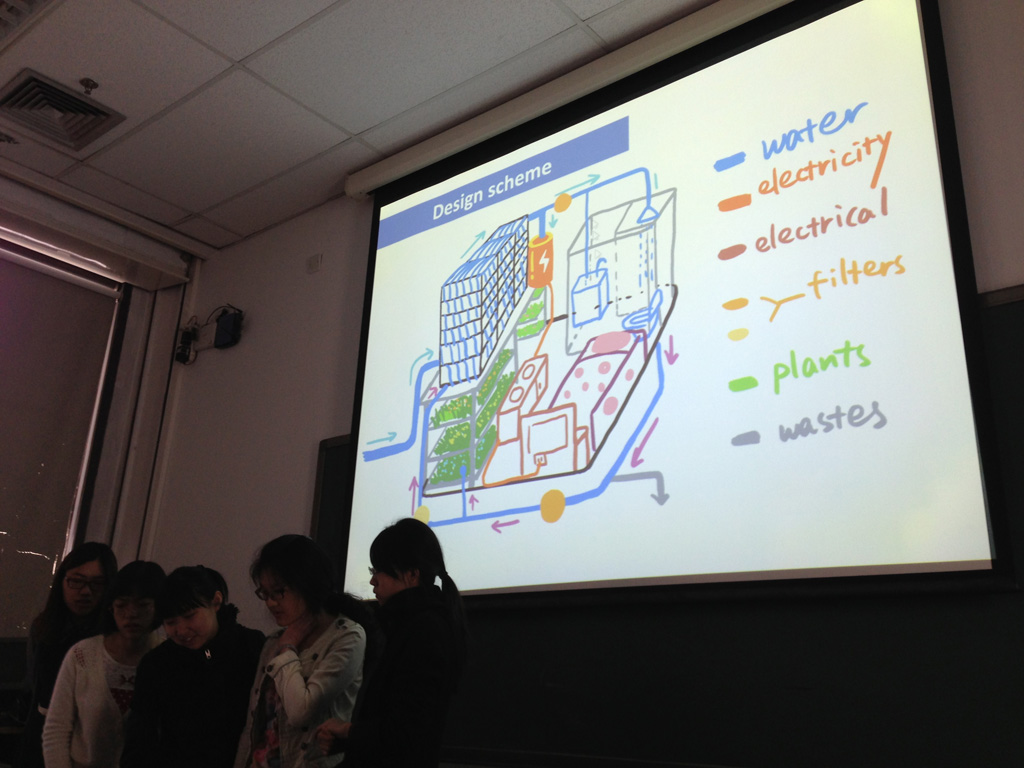

All in all, my own situation here in Beijing for a month gives me the occasion to really experience and analyze my own "deterritorialized" way of living, as I fully rely on software and networks architectures to keep working with the rest of the team in Switzerland (vpn to bypass some digital territorialities, clouds services of all sorts, video calls, file exchanges, etc.), as well as to periodically relocate myself with the help of an american gps service or to speak and exchange with people here.
I really look forward for the results of the workshop and of our own work! So more about it in the coming days/weeks...
Wednesday, March 06. 2013
Via The New York Times
-----
A City Prepares for a Warm Long-Term Forecast
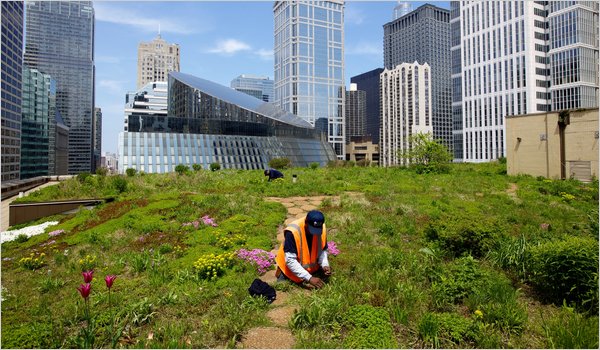
CHICAGO — The Windy City is preparing for a heat wave — a permanent one.
Climate scientists have told city planners that based on current trends, Chicago will feel more like Baton Rouge than a Northern metropolis before the end of this century.
So, Chicago is getting ready for a wetter, steamier future. Public alleyways are being repaved with materials that are permeable to water. The white oak, the state tree of Illinois, has been banned from city planting lists, and swamp oaks and sweet gum trees from the South have been given new priority. Thermal radar is being used to map the city’s hottest spots, which are then targets for pavement removal and the addition of vegetation to roofs. And air-conditioners are being considered for all 750 public schools, which until now have been heated but rarely cooled.
“Cities adapt or they go away,” said Aaron N. Durnbaugh, deputy commissioner of Chicago’s Department of Environment. “Climate change is happening in both real and dramatic ways, but also in slow, pervasive ways. We can handle it, but we do need to acknowledge it. We are on a 50-year cycle, but we need to get going.”
Across America and in Congress, the very existence of climate change continues to be challenged — especially by conservatives. The skeptics are supported by constituents wary of science and concerned about the economic impacts of stronger regulation. Yet even as the debate rages on, city and state planners are beginning to prepare.
The precise consequences of the increase of man-made greenhouse gases in the atmosphere are hard to determine, but scientists are predicting significant sea level rise; more extreme weather events like storms, tornadoes and blizzards; and, of course, much more heat. New York City, which is doing its own adaptation planning, is worried about flooding from the rising ocean. The Navy has a task force on climate change that says it should be preparing to police the equivalent of an extra sea as the Arctic ice melts.
Some of these events will occur in the near-enough term that local governments are under pressure to act. Insurance companies are applying pressure in high-risk areas, essentially saying adapt or pay higher premiums — especially in urban and commercial areas.
The reinsurance giant Swiss Re, for example, has said that if the shore communities of four Gulf Coast states choose not to implement adaptation strategies, they could see annual climate-change related damages jump 65 percent a year to $23 billion by 2030.
“Society needs to reduce its vulnerability to climate risks, and as long as they remain manageable, they remain insurable, which is our interest as well,” said Mark D. Way, head of Swiss Re’s sustainable development for the Americas.
Melissa Stults, the climate director for ICLEI USA, an association of local governments, said that many of the administrations she was dealing with were following a strategy of “discreetly integrating preparedness into traditional planning efforts.”
Second City First
Chicago is often called the Second City, but it is way out in front of most in terms of adaptation.
The effort began in 2006, under the mayor at the time, Richard M. Daley. He said he was inspired in part by the Kyoto international treaty for reducing carbon emissions, which took effect in 2005, and also by an aspiration to raise Chicago’s profile as an environmentally friendly town.
As a first step, the city wanted to model how global warming might play out locally. Foundations, eager to get local governments moving, put up some money.
“There was real assumption that Chicago could be a model for other places,” said Adele Simmons, president of Global Philanthropy Partnership, a nonprofit group based in Chicago that helped bring in $700,000 at the early stages.
Climatologists took into account a century’s worth of historical observations of daily temperatures and precipitation from 15 Chicago-area weather stations as well as the effect of Lake Michigan in moderating extreme heat and cold to come up with a range of possibilities based on a higher and lower range of worldwide carbon emissions.
The forecasts, while not out of line with global predictions, shocked city planners.
If world carbon emissions continued apace, the scientists said, Chicago would have summers like the Deep South, with as many as 72 days over 90 degrees before the end of the century. For most of the 20th century, the city averaged fewer than 15.
By 2070, Chicago could expect 35 percent more precipitation in winter and spring, but 20 percent less in summer and fall. By then, the conditions would have changed enough to make the area’s plant hardiness zone akin to Birmingham, Ala.
But what would that mean in real-life consequences? A private risk assessment firm was hired, and the resulting report read like an urban disaster film minus Godzilla.
The city could see heat-related deaths reaching 1,200 a year. The increasing occurrences of freezes and thaws (the root of potholes) would cause billions of dollars’ worth of deterioration to building facades, bridges and roads. Termites, never previously able to withstand Chicago’s winters, would start gorging on wooden frames.
Armed with the forecasts, the city prioritized which adaptations would save the most money and would be the most feasible in the light of tight budgets and public skepticism.
“We put each of the priorities through a lens of political, economic and technical,” said Suzanne Malec-McKenna, the commissioner of Chicago’s Department of Environment. “What is it, if you will, that will pass the laugh test?”
Among the ideas rejected, Ms. Malec-McKenna said, were plans to immediately shut down local coal-powered energy plants — too much cost for too little payback.
For actions the city felt were necessary but not affordable, it got help again from a local institution, the Civic Consulting Alliance, a nonprofit organization that builds pro bono teams of business experts. In this case, the alliance convinced consulting firms to donate $14 million worth of hours to projects like designing an electric car infrastructure and planning how to move the city toward zero waste.
Mr. Daley embraced the project. He convened 20 city departments in 2010 and told them to weigh their planning dollars against the changes experts were predicting. The department heads continued to meet quarterly, and members of Mayor Rahm Emanuel’s administration have said he is committed to moving the goals of the plan forward, albeit with an added emphasis on “projects that accelerate jobs and economic development.”
Updating Infrastructure
Much of Chicago’s adaptation work is about transforming paved spaces. “Cities are hard spaces that trap water and heat,” said Janet L. Attarian, a director of streetscapes at the city’s Department of Transportation. “Alleys and streets account for 25 percent of groundcover, and closer to 40 percent when parking lots are included.”
The city’s 13,000 concrete alleyways were originally built without drainage and are a nightmare every time it rains. Storm water pours off the hard surfaces and routinely floods basements and renders low-lying roads and underpasses unusable.
To make matters worse, many of the pipes that handle storm overflow also handle raw sewage. After a very heavy rain, if overflow pipes become congested, sewage backs up into basements or is released with the rainwater into the Chicago River — an emergency response that has attracted the scrutiny of the Environmental Protection Agency.
As the region warms, Chicago is expecting more frequent and extreme storms. In the last three years, the city has had two intense storms classified as 100-year events.
So the work planned for a six-point intersection on the South Side with flooding and other issues is a prototype. The sidewalk in front of the high school on Cermak Road has been widened to include planting areas that are lower than the street surface. This not only encourages more pedestrian traffic, but also provides shade and landscaping. These will be filled with drought-resistant plants like butterfly weed and spartina grasses that sponge up excess water and help filter pollutants like de-icing salts. In some places, unabsorbed water will seep into storage tanks beneath the streets so it can be used later for watering plants or in new decorative fountains in front of the high school.
The bike lanes and parking spaces being added along the street are covered with permeable pavers, a weave of pavement that allows 80 percent of rainwater to filter through it to the ground below. Already 150 alleyways have been remade in this way.
The light-reflecting pavement is Chicago’s own mix and includes recycled tires. Rubbery additives help the asphalt expand in heat without buckling and to contract without cracking.
The new streets bring new challenges, of course. The permeable pavers have to be specially cleaned or they eventually become clogged with silt and lose effectiveness.
Still, the new construction is no more expensive than traditional costs, Ms. Attarian said. Transforming one alleyway costs about $150,000. But now, she said, “We can put a fire hose on it full blast and the water seeps right in.”
Reconsidering the Trees
Awareness of climate change has filled Chicago city planners with deep concern for the trees.
Not only are they beautiful, said Ms. Malec-McKenna, herself trained as a horticulturalist, but their shade also provides immediate relief to urban heat islands. Trees improve air quality by absorbing carbon dioxide, and their leaves can keep 20 percent of an average rain from hitting the pavement.
Chicago spends over $10 million a year planting roughly 2,200 trees. From 1991 to 2008, the city added so many that officials estimate tree cover increased to 17.6 percent from 11 percent. The goal is to exceed 23 percent this decade.
The problem is that for trees to reach their expected lifespan — up to 90 years — they have to be able to endure hotter conditions. Chicago has already changed from one growing zone to another in the last 30 years, and it expects to change several times again by 2070.
Knowing this, planners asked experts at the city’s botanical garden and Morton Arboretum to evaluate their planting list. They were told to remove six of the most common tree species.
Off came the ash trees that account for 17 percent of Chicago tree cover, or more than any other tree. Gone, too, are the enormous Norway maples, which provide the most amount of shade.
A warming climate will make them more susceptible to plagues like emerald ash disease. Already white oak, the state tree of Illinois, is on the decline and, like several species of conifer, is expected to be extinct from the region within decades.
So Chicago is turning to swamp white oaks and bald cypress. It is like the rest of adaptation strategy, Ms. Malec-McKenna explains: “A constant ongoing process to make sure we are as resilient as we can be in facing the future.”
Personal comment:
To be read in connection with this previous post about our warming world: One degree (Celsius) of separation, huge differences. As well as with this post by Pruned: Stormproofing Cities, as well as possibly with this one I posted a few month ago regarding the idea of inhabiting the hurricanes (pathways).
Thursday, February 07. 2013
Note: I'm again here joining two recent posts. First, what it could climatically and therefore spatially, geographically, energetically, socialy, ... mean, degree after degree to increase the average temperature of the Earth and second, an information map about our warming world...
It is an unsigned paper, so it certainly need to be cross-checked, which I haven't done (time, time...)! But I post it nevertheless as it points out some believable consequences, yet very dark. As many people say now, we don't have much time left to start acting, strong (7-10 years).
Via Berens Finance (!)
-----
A degree by degree explanation of what will happen when the earth warms
-
Even if greenhouse emissions stopped overnight the concentrations already in the atmosphere would still mean a global rise of between 0.5 and 1C. A shift of a single degree is barely perceptible to human skin, but it’s not human skin we’re talking about. It’s the planet; and an average increase of one degree across its entire surface means huge changes in climatic extremes.
Six thousand years ago, when the world was one degree warmer than it is now, the American agricultural heartland around Nebraska was desert. It suffered a short reprise during the dust- bowl years of the 1930s, when the topsoil blew away and hundreds of thousands of refugees trailed through the dust to an uncertain welcome further west. The effect of one-degree warming, therefore, requires no great feat of imagination.
“The western United States once again could suffer perennial droughts, far worse than the 1930s. Deserts will reappear particularly in Nebraska, but also in eastern Montana, Wyoming and Arizona, northern Texas and Oklahoma. As dust and sandstorms turn day into night across thousands of miles of former prairie, farmsteads, roads and even entire towns will be engulfed by sand.”
What’s bad for America will be worse for poorer countries closer to the equator. It has beencalculated that a one-degree increase would eliminate fresh water from a third of the world’s land surface by 2100. Again we have seen what this means. There was an incident in the summer of 2005: One tributary fell so low that miles of exposed riverbank dried out into sand dunes, with winds whipping up thick sandstorms. As desperate villagers looked out onto baking mud instead of flowing water, the army was drafted in to ferry precious drinking water up the river – by helicopter, since most of the river was too low to be navigable by boat. The river in question was not some small, insignificant trickle in Sussex. It was the Amazon.
While tropical lands teeter on the brink, the Arctic already may have passed the point of no return. Warming near the pole is much faster than the global average, with the result that Arctic icecaps and glaciers have lost 400 cubic kilometres of ice in 40 years. Permafrost – ground that has lain frozen for thousands of years – is dissolving into mud and lakes, destabilising whole areas as the ground collapses beneath buildings, roads and pipelines. As polar bears and Inuits are being pushed off the top of the planet, previous predictions are starting to look optimistic. Earlier snowmelt means more summer heat goes into the air and ground rather than into melting snow, raising temperatures in a positive feedback effect. More dark shrubs and forest on formerly bleak tundra means still more heat is absorbed by vegetation.
Out at sea the pace is even faster. Whilst snow-covered ice reflects more than 80% of the sun’s heat, the darker ocean absorbs up to 95% of solar radiation. Once sea ice begins to melt, in other words, the process becomes self-reinforcing. More ocean surface is revealed, absorbing solar heat, raising temperatures and making it unlikelier that ice will re-form next winter. The disappearance of 720,000 square kilometres of supposedly permanent ice in a single year testifies to the rapidity of planetary change. If you have ever wondered what it will feel like when the Earth crosses a tipping point, savour the moment.
Mountains, too, are starting to come apart. In the Alps, most ground above 3,000 metres is stabilised by permafrost. In the summer of 2003, however, the melt zone climbed right up to 4,600 metres, higher than the summit of the Matterhorn and nearly as high as Mont Blanc. With the glue of millennia melting away, rocks showered down and 50 climbers died. As temperatures go on edging upwards, it won’t just be mountaineers who flee. Whole towns and villages will be at risk. Some towns, like Pontresina in eastern Switzerland, have already begun building bulwarks against landslides.
At the opposite end of the scale, low-lying atoll countries such as the Maldives will be preparing for extinction as sea levels rise, and mainland coasts – in particular the eastern US and Gulf of Mexico, the Caribbean and Pacific islands and the Bay of Bengal – will be hit by stronger and stronger hurricanes as the water warms. Hurricane Katrina, which in 2005 hit New Orleans with the combined impacts of earthquake and flood, was a nightmare precursor of what the future holds.
Most striking of all was seeing how people behaved once the veneer of civilisation had been torn away. Most victims were poor and black, left to fend for themselves as the police either joined in the looting or deserted the area. Four days into the crisis, survivors were packed into the city’s Superdome, living next to overflowing toilets and rotting bodies as gangs of young men with guns seized the only food and water available. Perhaps the most memorable scene was a single military helicopter landing for just a few minutes, its crew flinging food parcels and water bottles out onto the ground before hurriedly taking off again as if from a war zone. In scenes more like a Third World refugee camp than an American urban centre, young men fought for the water as pregnant women and the elderly looked on with nothing. Don’t blame them for behaving like this, I thought. It’s what happens when people are desperate.
Chance of avoiding one degree of global warming: zero.
BETWEEN ONE AND TWO DEGREES OF WARMING
At this level, expected within 40 years, the hot European summer of 2003 will be the annual norm. Anything that could be called a heatwave thereafter will be of Saharan intensity. Even in average years, people will die of heat stress.
The first symptoms may be minor. A person will feel slightly nauseous, dizzy and irritable. It needn’t be an emergency: an hour or so lying down in a cooler area, sipping water, will cure it. But in Paris, August 2003, there were no cooler areas, especially for elderly people.
Once body temperature reaches 41C (104F) its thermoregulatory system begins to break down. Sweating ceases and breathing becomes shallow and rapid. The pulse quickens, and the victim may lapse into a coma. Unless drastic measures are taken to reduce the body’s core temperature, the brain is starved of oxygen and vital organs begin to fail. Death will be only minutes away unless the emergency services can quickly get the victim into intensive care.
These emergency services failed to save more than 10,000 French in the summer of 2003. Mortuaries ran out of space as hundreds of dead bodies were brought in each night. Across Europe as a whole, the heatwave is believed to have cost between 22,000 and 35,000 lives. Agriculture, too, was devastated. Farmers lost $12 billion worth of crops, and Portugal alone suffered $12 billion of forest-fire damage. The flows of the River Po in Italy, Rhine in Germany and Loire in France all shrank to historic lows. Barges ran aground, and there was not enough water for irrigation and hydroelectricity. Melt rates in the Alps, where some glaciers lost 10% of their mass, were not just a record – they doubled the previous record of 1998. According to the Hadley centre, more than half the European summers by 2040 will be hotter than this. Extreme summers will take a much heavier toll of human life, with body counts likely to reach hundreds of thousands. Crops will bake in the fields, and forests will die off and burn. Even so, the short-term effects may not be the worst:
From the beech forests of northern Europe to the evergreen oaks of the Mediterranean, plant growth across the whole landmass in 2003 slowed and then stopped. Instead of absorbing carbon dioxide, the stressed plants began to emit it. Around half a billion tonnes of carbon was added to the atmosphere from European plants, equivalent to a twelfth of global emissions from fossil fuels. This is a positive feedback of critical importance, because it suggests that, as temperatures rise, carbon emissions from forests and soils will also rise. If these land-based emissions are sustained over long periods, global warming could spiral out of control.
In the two-degree world, nobody will think of taking Mediterranean holidays. The movement of people from northern Europe to the Mediterranean is likely to reverse, switching eventually into a mass scramble as Saharan heatwaves sweep across the Med. People everywhere will think twice about moving to the coast. When temperatures were last between 1 and 2C higher than they are now, 125,000 years ago, sea levels were five or six metres higher too. All this “lost” water is in the polar ice that is now melting. Forecasters predict that the “tipping point” for Greenland won’t arrive until average temperatures have risen by 2.7C. The snag is that Greenland is warming much faster than the rest of the world – 2.2 times the global average. “Divide one figure by the other,” says Lynas, “and the result should ring alarm bells across the world. Greenland will tip into irreversible melt once global temperatures rise past a mere 1.2C. The ensuing sea-level ?rise will be far more than the half-metre that ?the IPCC has predicted for the end of the century. Scientists point out that sea levels at the end of the last ice age shot up by a metre every 20 years for four centuries, and that Greenland’s ice, in the words of one glaciologist, is now thinning like mad and flowing much faster than it ought to. Its biggest outflow glacier, Jakobshavn Isbrae, has thinned by 15 metres every year since 1997, and its speed of flow has doubled. At this rate the whole Greenland ice sheet would vanish within 140 years. Miami would disappear, as would most of Manhattan. Central London would be flooded. Bangkok, Bombay and Shanghai would lose most of their area. In all, half of humanity would have to move to higher ground.
Not only coastal communities will suffer. As mountains lose their glaciers, so people will lose their water supplies. The entire Indian subcontinent will be fighting for survival. As the glaciers disappear from all but the highest peaks, their runoff will cease to power the massive rivers that deliver vital freshwater to hundreds of millions. Water shortages and famine will be the result, destabilising the entire region. And this time the epicentre of the disaster won’t be India, Nepal or Bangladesh, but nuclear-armed Pakistan.
Everywhere, ecosystems will unravel as species either migrate or fall out of synch with each other. By the time global temperatures reach two degrees of warming in 2050, more than a third of all living species will face extinction.
Chance of avoiding two degrees of global warming: 93%, but only if emissions of greenhouse gases are reduced by 60% over the next 10 years.
BETWEEN TWO AND THREE DEGREES OF WARMING
Up to this point, assuming that governments have planned carefully and farmers have converted to more appropriate crops, not too many people outside subtropical Africa need have starved. Beyond two degrees, however, preventing mass starvation will be as easy as halting the cycles of the moon. First millions, then billions, of people will face an increasingly tough battle to survive.
To find anything comparable we have to go back to the Pliocene – last epoch of the Tertiary period, 3m years ago. There were no continental glaciers in the northern hemisphere (trees grew in the Arctic), and sea levels were 25 metres higher than today’s. In this kind of heat, the death of the Amazon is as inevitable as the melting of Greenland. The paper spelling it out is the very one whose apocalyptic message so shocked in 2000. Scientists at the Hadley centre feared that earlier climate models, which showed global warming as a straightforward linear progression, were too simplistic in their assumption that land and the oceans would remain inert as their temperatures rose. Correctly as it would turn out, they predicted positive feedback.
Warmer seas absorb less carbon dioxide, leaving more to accumulate in the atmosphere and intensify global warming. On land, matters would be even worse. Huge amounts of carbon are stored in the soil, the half-rotted remains of dead vegetation. The generally accepted estimate is that the soil carbon reservoir contains some 1600 gigatonnes, more than double the entire carbon content of the atmosphere. As soil warms, bacteria accelerate the breakdown of this stored carbon, releasing it into the atmosphere.
The end of the world is nigh. A three-degree increase in global temperature – possible as early as 2050 – would throw the carbon cycle into reverse. Instead of absorbing carbon dioxide, vegetation and soils start to release it. So much carbon pours into the atmosphere that it pumps up atmospheric concentrations by 250 parts per million by 2100, boosting global warming by another 1.5C. In other words, the Hadley team had discovered that carbon-cycle feedbacks could tip the planet into runaway global warming by the middle of this century – much earlier than anyone had expected.
Confirmation came from the land itself. Climate models are routinely tested against historical data. In this case, scientists checked 25 years’ worth of soil samples from 6,000 sites across the UK. The result was another black joke. As temperatures gradually rose the scientists found that huge amounts of carbon had been released naturally from the soils. They totted it all up and discovered – irony of ironies – that the 13m tonnes of carbon British soils were emitting annually was enough to wipe out all the country’s efforts to comply with the Kyoto Protocol.” All soils will be affected by the rising heat, but none as badly as the Amazon’s. “Catastrophe” is almost too small a word for the loss of the rainforest. Its 7m square kilometres produce 10% of the world’s entire photosynthetic output from plants. Drought and heat will cripple it; fire will finish it off. In human terms, the effect on the planet will be like cutting off oxygen during an asthma attack.
In the US and Australia, people will curse the climate-denying governments of Bush and Howard. No matter what later administrations may do, it will not be enough to keep the mercury down. With new “super-hurricanes” growing from the warming sea, Houston could be destroyed by 2045, and Australia will be a death trap. “Farming and food production will tip into irreversible decline. Salt water will creep up the stricken rivers, poisoning ground water. Higher temperatures mean greater evaporation, further drying out vegetation and soils, and causing huge losses from reservoirs. In state capitals, heat every year is likely to kill between 8,000 and 15,000 mainly elderly people.
It is all too easy to visualise what will happen in Africa. In Central America, too, tens of millions will have little to put on their tables. Even a moderate drought there in 2001 meant hundreds of thousands had to rely on food aid. This won’t be an option when world supplies are stretched to breaking point (grain yields decline by 10% for every degree of heat above 30C, and at 40C they are zero). Nobody need look to the US, which will have problems of its own. As the mountains lose their snow, so cities and farms in the west will lose their water and dried-out forests and grasslands will perish at the first spark.
The Indian subcontinent meanwhile will be choking on dust. All of human history shows that, given the choice between starving in situ and moving, people move. In the latter part of the century tens of millions of Pakistani citizens may be facing this choice. Pakistan may find itself joining the growing list of failed states, as civil administration collapses and armed gangs seize what little food is left.
As the land burns, so the sea will go on rising. Even by the most optimistic calculation, 80% of Arctic sea ice by now will be gone, and the rest will soon follow. New York will flood; the catastrophe that struck eastern England in 1953 will become an unremarkable regular event; and the map of the Netherlands will be torn up by the North Sea. Everywhere, starving people will be on the move – from Central America into Mexico and the US, and from Africa into Europe, where resurgent fascist parties will win votes by promising to keep them out.
Chance of avoiding three degrees of global warming: poor if the rise reaches two degrees and triggers carbon-cycle feedbacks from soils and plants.
BETWEEN THREE AND FOUR DEGREES OF WARMING
The stream of refugees will now include those fleeing from coasts to safer interiors – millions at a time when storms hit. Where they persist, coastal cities will become fortified islands. The world economy, too, will be threadbare. As direct losses, social instability and insurance payouts cascade through the system, the funds to support displaced people will be increasingly scarce. Sea levels will be rampaging upwards – in this temperature range, both poles are certain to melt, causing an eventual rise of 50 metres. “I am not suggesting it would be instantaneous. In fact it would take centuries, and probably millennia, to melt all of the Antarctic’s ice. But it could yield sea-level rises of a metre or so every 20 years – far beyond our capacity to adapt.Oxford would sit on one of many coastlines in a UK reduced to an archipelago of tiny islands.
More immediately, China is on a collision course with the planet. By 2030, if its people are consuming at the same rate as Americans, they will eat two-thirds of the entire global harvest and burn 100m barrels of oil a day, or 125% of current world output. That prospect alone contains all the ingredients of catastrophe. But it’s worse than that: “By the latter third of the 21st century, if global temperatures are more than three degrees higher than now, China’s agricultural production will crash. It will face the task of feeding 1.5bn much richer people – 200m more than now – on two thirds of current supplies.” For people throughout much of the world, starvation will be a regular threat; but it will not be the only one.
The summer will get longer still, as soaring temperatures reduce forests to tinderwood and cities to boiling morgues. Temperatures in the Home Counties could reach 45C – the sort of climate experienced today in Marrakech. Droughts will put the south-east of England on the global list of water-stressed areas, with farmers competing against cities for dwindling supplies from rivers and reservoirs.
Air-conditioning will be mandatory for anyone wanting to stay cool. This in turn will put ever more stress on energy systems, which could pour more greenhouse gases into the air if coal and gas-fired power stations ramp up their output, hydroelectric sources dwindle and renewables fail to take up the slack. The abandonment of the Mediterranean will send even more people north to “overcrowded refuges in the Baltic, Scandinavia and the British Isles.
Britain will have problems of its own. As flood plains are more regularly inundated, a general retreat out of high risk areas is likely. Millions of people will lose their lifetime investments in houses that become uninsurable and therefore unsaleable? The Lancashire/Humber corridor is expected to be among the worst affected regions, as are the Thames Valley, eastern Devon and towns around the already flood-prone Severn estuary like Monmouth and Bristol. The entire English coast from the Isle of Wight to Middlesbrough is classified as at ‘very high’ or ‘extreme’ risk, as is the whole of Cardigan Bay in Wales.
One of the most dangerous of all feedbacks will now be kicking in – the runaway thaw of permafrost. Scientists believe at least 500 billion tonnes of carbon are waiting to be released from the Arctic ice, though none yet has put a figure on what it will add to global warming. One degree? Two? Three? The pointers are ominous.
As with Amazon collapse and the carbon-cycle feedback in the three-degree worldstabilising global temperatures at four degrees above current levels may not be possible. If we reach three degrees, therefore, that leads inexorably to four degrees, which leads inexorably to five?
Chance of avoiding four degrees of global warming: poor if the rise reaches three degrees and triggers a runaway thaw of permafrost.
BETWEEN FOUR AND FIVE DEGREES OF WARMING
We are looking now at an entirely different planet. Ice sheets have vanished from both poles; rainforests have burnt up and turned to desert; the dry and lifeless Alps resemble the High Atlas; rising seas are scouring deep into continental interiors. One temptation may be to shift populations from dry areas to the newly thawed regions of the far north, in Canada and Siberia. Even here, though, summers may be too hot for crops to be grown away from the coasts; and there is no guarantee that northern governments will admit southern refugees. Lynas recalls James Lovelock’s suspicion that Siberia and Canada would be invaded by China and the US, each hammering another nail into humanity’s coffin. Any armed conflict, particularly involving nuclear weapons, would of course further increase the planetary surface area uninhabitable for humans.
When temperatures were at a similar level 55m years ago, following a very sudden burst of global warming in the early Eocene, alligators and other subtropical species were living high in the Arctic. What had caused the climate to flip? Suspicion rests on methane hydrate – “an ice-like combination of methane and water that forms under the intense cold and pressure of the deep sea”, and which escapes with explosive force when tapped. Evidence of a submarine landslide off Florida, and of huge volcanic eruptions under the North Atlantic, raises the possibility of trapped methane – a greenhouse gas 20 times more potent than carbon dioxide – being released in a giant belch that pushed global temperatures through the roof.
Summer heatwaves scorched the vegetation out of continental Spain, leaving a desert terrain which was heavily eroded by winter rainstorms. Palm mangroves grew as far north as England and Belgium, and the Arctic Ocean was so warm that Mediterranean algae thrived. In short, it was a world much like the one we are heading into this century. Although the total amount of carbon in the atmosphere during the Paleocene-Eocene thermal maximum, or PETM, as scientists call it, was more than today’s, the rate of increase in the 21st century may be 30 times faster. It may well be the fastest increase the world has ever seen – faster even than the episodes that caused catastrophic mass extinctions.
Globalism in the five-degree world will break down into something more like parochialism. Customers will have nothing to buy because producers will have nothing to sell. With no possibility of international aid, migrants will have to force their way into the few remaining habitable enclaves and fight for survival.
Where no refuge is available, civil war and a collapse into racial or communal conflict seems the likely outcome. Isolated survivalism, however, may be as impracticable as dialling for room service. How many of us could really trap or kill enough game to feed a family? Even if large numbers of people did successfully manage to fan out into the countryside, wildlife populations would quickly dwindle under the pressure. Supporting a hunter-gatherer lifestyle takes 10 to 100 times the land per person that a settled agricultural community needs. A large-scale resort to survivalism would turn into a further disaster for biodiversity as hungry humans killed and ate anything that moved. Including, perhaps, each other. Invaders do not take kindly to residents denying them food. History suggests that if a stockpile is discovered, the householder and his family may be tortured and killed. Look for comparison to the experience of present-day Somalia, Sudan or Burundi, where conflicts over scarce land and food are at the root of lingering tribal wars and state collapse.
Chance of avoiding five degrees of global warming: negligible if the rise reaches four degrees and releases trapped methane from the sea bed.
BETWEEN FIVE AND SIX DEGREES OF WARMING
Although warming on this scale lies within the IPCC’s officially endorsed range of 21st-century possibilities, climate models have little to say about what Lynas, echoing Dante, describes as “the Sixth Circle of Hell”. To see the most recent climatic lookalike, we have to turn the geological clock back between 144m and 65m years, to the Cretaceous, which ended with the extinction of the dinosaurs. There was an even closer fit at the end of the Permian, 251m years ago, when global temperatures rose by – yes – six degrees, and 95% of species were wiped out.
That episode was the worst ever endured by life on Earth, the closest the planet has come to ending up a dead and desolate rock in space.” On land, the only winners were fungi that flourished on dying trees and shrubs. At sea there were only losers. Warm water is a killer. Less oxygen can dissolve, so conditions become stagnant and anoxic. Oxygen-breathing water-dwellers – all the higher forms of life from plankton to sharks – face suffocation. Warm water also expands, and sea levels rose by 20 metres.” The resulting “super-hurricanes” hitting the coasts would have triggered flash floods that no living thing could have survived.
There are aspects of the so-called “end-Permian extinction” that are unlikely to recur – most importantly, the vast volcanic eruption in Siberia that spread magma hundreds of metres thick over an area bigger than western Europe and shot billions of tonnes of CO2 into the atmosphere. That is small comfort, however, for beneath the oceans, another monster stirred – the same that would bring a devastating end to the Palaeocene nearly 200m years later, and that still lies in wait today. Methane hydrate.
What happens when warming water releases pent-up gas from the sea bed: First, a small disturbance drives a gas-saturated parcel of water upwards. As it rises, bubbles begin to appear, as dissolved gas fizzles out with reducing pressure – just as a bottle of lemonade overflows if the top is taken off too quickly. These bubbles make the parcel of water still more buoyant, accelerating its rise through the water. As it surges upwards, reaching explosive force, it drags surrounding water up with it. At the surface, water is shot hundreds of metres into the air as the released gas blasts into the atmosphere. Shockwaves propagate outwards in all directions, triggering more eruptions nearby.
The eruption is more than just another positive feedback in the quickening process of global warming. Unlike CO2, methane is flammable. Even in air-methane concentrations as low as 5%, the mixture could ignite from lightning or some other spark and send fireballs tearing across the sky. The effect would be much like that of the fuel-air explosives used by the US and Russian armies – so-called “vacuum bombs” that ignite fuel droplets above a target. According to the CIA, those near the ignition point are obliterated. Those at the fringes are likely to suffer many internal injuries, including burst eardrums, severe concussion, ruptured lungs and internal organs, and possibly blindness.” Such tactical weapons, however, are squibs when set against methane-air clouds from oceanic eruptions. Scientists calculate that they could “destroy terrestrial life almost entirely (251m years ago, only one large land animal, the pig-like lystrosaurus, survived). It has been estimated that a large eruption in future could release energy equivalent to 108 megatonnes of TNT – 100,000 times more than the world’s entire stockpile of nuclear weapons. Not even Lynas, for all his scientific propriety, can avoid the Hollywood ending. “It is not too difficult to imagine the ultimate nightmare, with oceanic methane eruptions near large population centres wiping out billions of people – perhaps in days. Imagine a ‘fuel-air explosive’ fireball racing towards a city – London, say, or Tokyo – the blast wave spreading out from the explosive centre with the speed and force of an atomic bomb. Buildings are flattened, people are incinerated where they stand, or left blind and deaf by the force of the explosion. Mix Hiroshima with post-Katrina New Orleans to get some idea of what such a catastrophe might look like: burnt survivors battling over food, wandering far and wide from empty cities.
Then would come hydrogen sulphide from the stagnant oceans. “It would be a silent killer: imagine the scene at Bhopal following the Union Carbide gas release in 1984, replayed first at coastal settlements, then continental interiors across the world. At the same time, as the ozone layer came under assault, we would feel the sun’s rays burning into our skin, and the first cell mutations would be triggering outbreaks of cancer among anyone who survived. Dante’s hell was a place of judgment, where humanity was for ever punished for its sins. With all the remaining forests burning, and the corpses of people, livestock and wildlife piling up in every continent, the six-degree world would be a harsh penalty indeed for the mundane crime of burning fossil energy.
------------
Via Information Aesthetics
-----
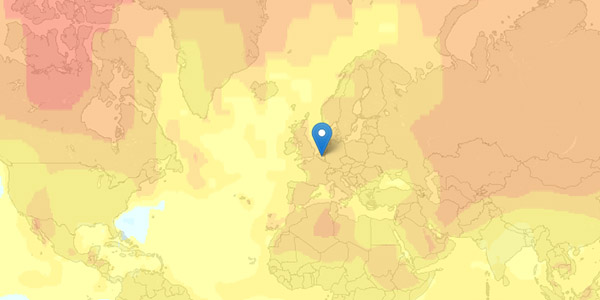
Warming World [newscientistapps.com], developed by Chris Amico and Peter Aldhous for the New Scientist, shows the distribution of ambient temperatures around the world, ranging from 1951 to now. The graphs and maps highlight the changes relative to the average temperatures measured between 1951 to 1980.
Users can click anywhere on the map and investigate an entire temperature record for that grid cell, retrieved via NASA's surface temperature analysis database GISTEMP, which is based on 6000 monitoring stations, ships and satellite measurements worldwide. Via the drop-down list at the top, users can also switch between different map overlays that summarize the average temperatures for different 20-year pictures. Accordingly, climate change become visible as the cool blue hues from previous decades are replaced with warm red and yellow hues around the start of the 20th Century.
Accordingly, this tool aims to communicate the reality and variability of recorded climate change, and compare that local picture with the trend for the global average temperature..
The accompanying article can be found here.
See also Cal-Adapt and Climate Change Media Watch.
----
Read also "An Alarm in the Offing on Climate Change", The New York Times.
Friday, November 16. 2012
Via The New York Times
-----
WASHINGTON — Climate change is accelerating, and it will place unparalleled strains on American military and intelligence agencies in coming years by causing ever more disruptive events around the globe, the nation’s top scientific research group said in a report issued Friday.
The group, the National Research Council, says in a study commissioned by the C.I.A. and other intelligence agencies that clusters of apparently unrelated events exacerbated by a warming climate will create more frequent but unpredictable crises in water supplies, food markets, energy supply chains and public health systems.
Hurricane Sandy provided a foretaste of what can be expected more often in the near future, the report’s lead author, John D. Steinbruner, said in an interview.
“This is the sort of thing we were talking about,” said Mr. Steinbruner, a longtime authority on national security. “You can debate the specific contribution of global warming to that storm. But we’re saying climate extremes are going to be more frequent, and this was an example of what they could mean. We’re also saying it could get a whole lot worse than that.”
Mr. Steinbruner, the director of the Center for International and Security Studies at the University of Maryland, said that humans are pouring carbon dioxide and other climate-altering gases into the atmosphere at a rate never before seen. “We know there will have to be major climatic adjustments — there’s no uncertainty about that — but we just don’t know the details,” he said. “We do know they will be big.”
The study was released 10 days late: its authors had been scheduled to brief intelligence officials on their findings the day Hurricane Sandy hit the East Coast, but the federal government was shut down because of the storm.
Climate-driven crises could lead to internal instability or international conflict and might force the United States to provide humanitarian assistance or, in some cases, military force to protect vital energy, economic or other interests, the study said.
The Defense Department has already taken major steps to plan for and adapt to climate change and has spent billions of dollars to make ships, aircraft and vehicles more fuel-efficient. Nonetheless, the 206-page study warns in sometimes bureaucratic language, the United States is ill prepared to assess and prepare for the catastrophes that a heated planet will produce.
“It is prudent to expect that over the course of a decade some climate events — including single events, conjunctions of events occurring simultaneously or in sequence in particular locations, and events affecting globally integrated systems that provide for human well-being — will produce consequences that exceed the capacity of the affected societies or global system to manage and that have global security implications serious enough to compel international response,” the report states.
In other words, states will fail, large populations subjected to famine, flood or disease will migrate across international borders, and national and international agencies will not have the resources to cope.
The report cites the simultaneous heat wave in Russia and floods in Pakistan in the summer of 2010 as disparate but linked climate-related events that taxed those societies.
It also cites the Nile River watershed as a place where climate-related conflict over water and farmland could arise as the combined populations of Egypt, Sudan and Ethiopia approach 300 million. South Korea and Saudi Arabia have purchased fertile land in the Nile watershed to produce crops to feed their people, but local forces could decide to seize the crops for their own use, potentially leading to international conflict, the report says.
The 18-month study is not the first such report from government agencies or research organizations to draw a direct link between climate change and national security concerns.
The National Intelligence Council produced a classified national intelligence estimate on climate change in 2008 and has issued a number of unclassified reports since then. The Pentagon and the White House have also highlighted the role of climate change in humanitarian crises and security threats.
The National Research Council recommends in the new report that all government agencies improve their ability to monitor the global climate and assess the risks to populations and critical resources around the world.
Yet Mr. Steinbruner said that as the need for more and better analysis is growing, government resources devoted to them are shrinking. Republicans in Congress objected to the C.I.A.’s creation of a climate change center and tried to deny money for it. The American weather satellite program is losing capability because of years of underfinancing and mismanagement, imperiling the ability to predict and monitor major storms.
Personal comment:
Following the previous post about hurricanes, another article by The NYT that strength the necessity to take into account the effects of climate extremes.
We've seen in the recent years projects taking into account floodings or higher levels of oceans. Probably should we also already consider more generally "climate extremes" (wind, floodings, rain, heat waves, etc.) that will occur more and more often at a global scale in the coming 50 years in the design of contemporary architectures, cities, landscapes and infrastructures. Undoubtedly a research project.
|
















 [Image: Via the
[Image: Via the  [Image: Via the
[Image: Via the 
 [Images: From a series of "light beacon studies" by Marta Nestorov].
[Images: From a series of "light beacon studies" by Marta Nestorov]. [Image: An instrument for analyzing "perception and interpretation of the aurora borealis" by Christopher Erdman].
[Image: An instrument for analyzing "perception and interpretation of the aurora borealis" by Christopher Erdman]. [Image: Device "for testing sound absorption qualities of snow," by Milja Lindberg and Liina Pikk].
[Image: Device "for testing sound absorption qualities of snow," by Milja Lindberg and Liina Pikk].
 [Images: The aforementioned device "used for testing sound absorption qualities of snow," by Milja Lindberg and Liina Pikk].
[Images: The aforementioned device "used for testing sound absorption qualities of snow," by Milja Lindberg and Liina Pikk].
 [Images: A device for performing "biomimicry of polar plants" by Clemens Hochreiter].
[Images: A device for performing "biomimicry of polar plants" by Clemens Hochreiter]. [Image: Device for studying the "insulation properties and light transmission" of ice tiles, by Daniela Miller].
[Image: Device for studying the "insulation properties and light transmission" of ice tiles, by Daniela Miller].

 [Images: Ice tiles by Daniela Miller].
[Images: Ice tiles by Daniela Miller].


 [Images: A "polar bear alarm" by studio director David Garcia].
[Images: A "polar bear alarm" by studio director David Garcia].










